How To Cut Concrete Garden Edging
Concrete Edging Stones – How to Line a Driveway or Pathway With Concrete Edging Stones
Using concrete edging stones when edging a path or driveway. In this DIY project we will show you how to lay concrete edging stones along a pathway or driveway. You will also learn how to get your edging stones straight and level and also how to concrete your edging stones down and ensure they resist any applied pressure.
If you are laying any kind of driveway, path or hard surface, concrete edging stones are the go to solution to ensure the surfacing itself is contained and prevented from spreading and that any edges are protected from damage.
This project can be read in conjunction with our project on laying a gravel driveway or path.
What is a Concrete Edging Stone?
A concrete edging stone is a mini kerb. Whereas kerbs are used for roads, edgings are used for driveways and paths. Usually, one edge has a rounded "bull nosed" edge which softens the look of the stone and also protects car tyres when used on a driveway.
This project deals with straight, concrete edging stones. There are many types of edging stones for varying uses around the garden, some just sit in soil, some on a mortar bed and some need concreting. Regardless of which type is used the principle of installation is the same.
Edging stones are used to stop the base spreading as weight is applied to it and as such must be laid in a strong mix of concrete themselves, or firmly embedded in soil if sinking straight into the ground.

Cross section of concrete edging stones at the side of a pathway
How to Lay Concrete Edging Stones Along a Driveway or Pathway
For the purposes of this guide we are going to be laying some concrete edging stones around the front edge of a driveway to prevent the top coating of shingle from escaping.
Step 1 – Excavate trench to lay edging stones in
To provide the required base and support for any concrete edging stones you must first dig a trench to lay your edging stones in.
For this project we were going to use 6×2 inch round top garden edging stones so the trench itself needed to be around 6 inches deep and 8 inches wide and run the full length of driveway area.
As there will roughly 2 inches of concrete in the base of the trench, this will allow roughly the top 2 inches of the edging stone to rise above ground level and contain the shingle for the driveway.
Ensure the base of the trench is nice and flat, smooth and level and free from any stones or similar objects.
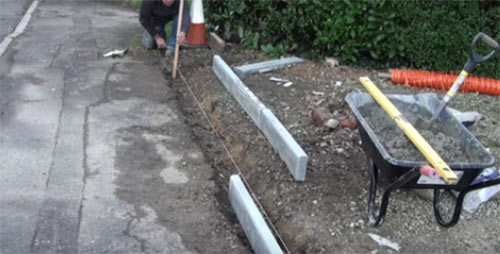
Dig out trench for edging stones and ensure base is flat and smooth
Step 2 – Lay and level a string line to follow
To ensure that all of your edging stones are laid in a straight and level line you need something to follow, in this case a string line.
Bang a stake in the centre of the trench at each end and then run your string line between them making sure that it is runs between the centre of each stake.
Once your string line is tied in position between the 2 stakes, lay a spirit level flat on the existing surface the edgings are butting up to, in this case a pavement and adjust the string level down to the spirit level.
This will give you roughly your 2 inches above ground level that the edgings will need to achieve in order to retain the driveway surface.
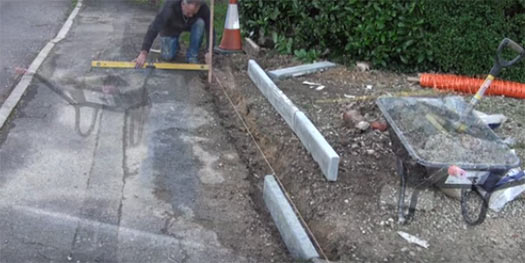
Set a string line and level against existing surface to provide a straight line to follow set at the correct gradient
Step 3 – Lay a concrete base in trench
A couple of inches (50-75mm) of concrete mixed at 6 to 1, 6 parts aggregate to 1 part Portland cement (see our mixing concrete project) is laid along the line you would like the edgings to follow.
Once the concrete is in the trench, smooth it over using a gauging trowel to provide a nice flat and level bed for each edging stone to sit on.

Lay concrete in the base of the trench for edging stones to lay on
Step 4 – Lay and get your edging stones straight and level
The next job is to start laying your edging stones in the trench. Each stone will sit towards the front of the trench so that there is around a 4 inch gap to the rear and around 2 inches at the front between the front face of the edging stone and in this case the pavement.
To get started, an edging stone is laid at each end of the trench and tapped to level, usually with a paving mallet or the handle of a lump or club hammer.
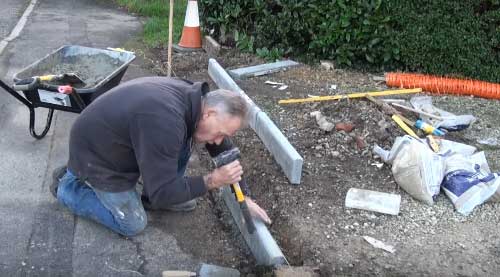
Lay edging stones in trench and level up using paving mallet or handle of lump hammer
Once the two end stones are in and the string line is in position you can lay the rest of the edgings. Tap each one down into the concrete butting one up against the next one. There is no need for a joint.
Level each stone against the line level and also use a spirit level to check levels along the front, rear and top of each stone and across adjoining edging stones.
Remember to take into account the slope of the drive or any other gradients that should be followed. If you have set your string line using a spirit level, levelled off of a nearby surface then the string line itself should follow the gradient that you need to lay to.

Laying concrete edging stones to follow a gradient using a string line
If using edgings on both sides, use a long piece of timber to level across. If the distance is too great, transfer the level using pegs banged into the ground.
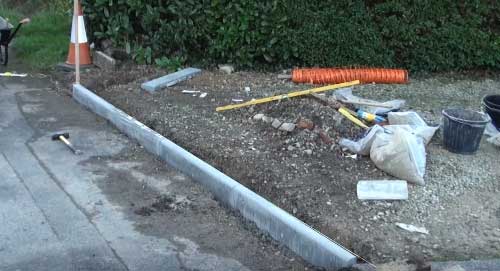
All edging stones laid in trench and ready for concreting
Step 5 – Cut edging stones where required
During laying, you may need to cut one or two edging stones to fit the length of the drive or path or even cut a mitre joints to create and angle. This can be done with an angle grinder.
Make sure you hire or buy stone cutting disks as metal cutting disks will not get through stone or concrete.
To cut a concrete edging stone using an angle grinder, simply measure and mark the stone at the point you need to cut and then chop through it with the grinder.
If you have never used an angle grinder it's a good idea to mark a cutting line all the way around the point you need to cut at so that you have a straight cutting line to follow.
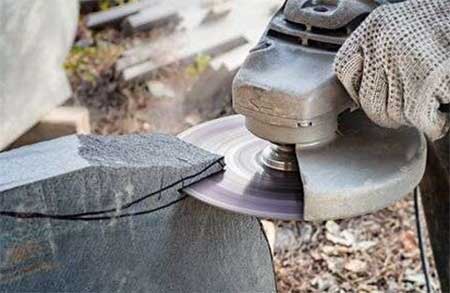
Cutting concrete using an angle grinder
Angle grinders can be tricky tools to use so before you use one, read our project on using an angle grinder here.
If you need to cut a mitre angle between two edging stones so that they can turn at a specific angle then you will first need to work out what that angle is. For information on how to calculate angles see our project here.
Step 6 – Lay concrete in front and behind edging stones (haunching)
When all the edging stones are in position in your trench, concrete is placed all along the back of all edgings, this is called haunching.
Almost always the main bulk of pressure against each edging stone will come from the front so most of the concrete needs to be at the back to provide the required support.
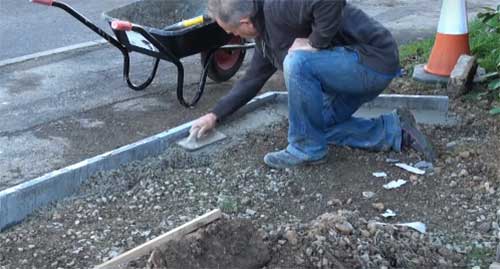
Laying haunching to support rear of edging stones
As you will probably have a fairly solid sub base of some kind at the front, in this case a macadam pavement, the gap between these will also need to be filled with some concrete. Once concrete has been laid, trowel it down to smooth it off for a nice finish.
When adding the rear haunching, remember to leave enough depth for a little soil if you are reinstating turf etc behind the stones and compact the concrete well using a flat piece of timber or preferably a wooden or plastic plastering float.
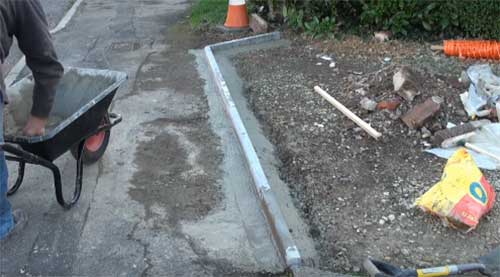
Gap between pavement and edging stones filled with concrete and smoothed over
Angle the concrete away from the stone so water does not sit on the top of the concrete.
As a rough rule of thumb, the haunching should extend at least half way up the rear side of each edging stone and it should extend out at least the full width of the edging stone to ensure the correct support.
You will then need to leave the concrete for at least 24 hours to fully set and once set, you can then get on with laying any finishing coverings.
As long as you take your time and ensure your prep work is done correctly e.g. your trench is the correct size, depth and nice and smooth, your string line is level and set to the correct gradient and your stones follow your line accurately, laying edging stones is a fairly straightforward job.
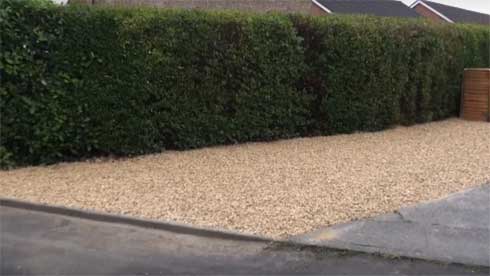
Concrete edging stones installed and driveway completed
All project content written and produced by , founder of DIY Doctor and industry expert in building technology.
How To Cut Concrete Garden Edging
Source: https://www.diydoctor.org.uk/projects/Edgings.htm
Posted by: harrisblapeneve.blogspot.com

0 Response to "How To Cut Concrete Garden Edging"
Post a Comment